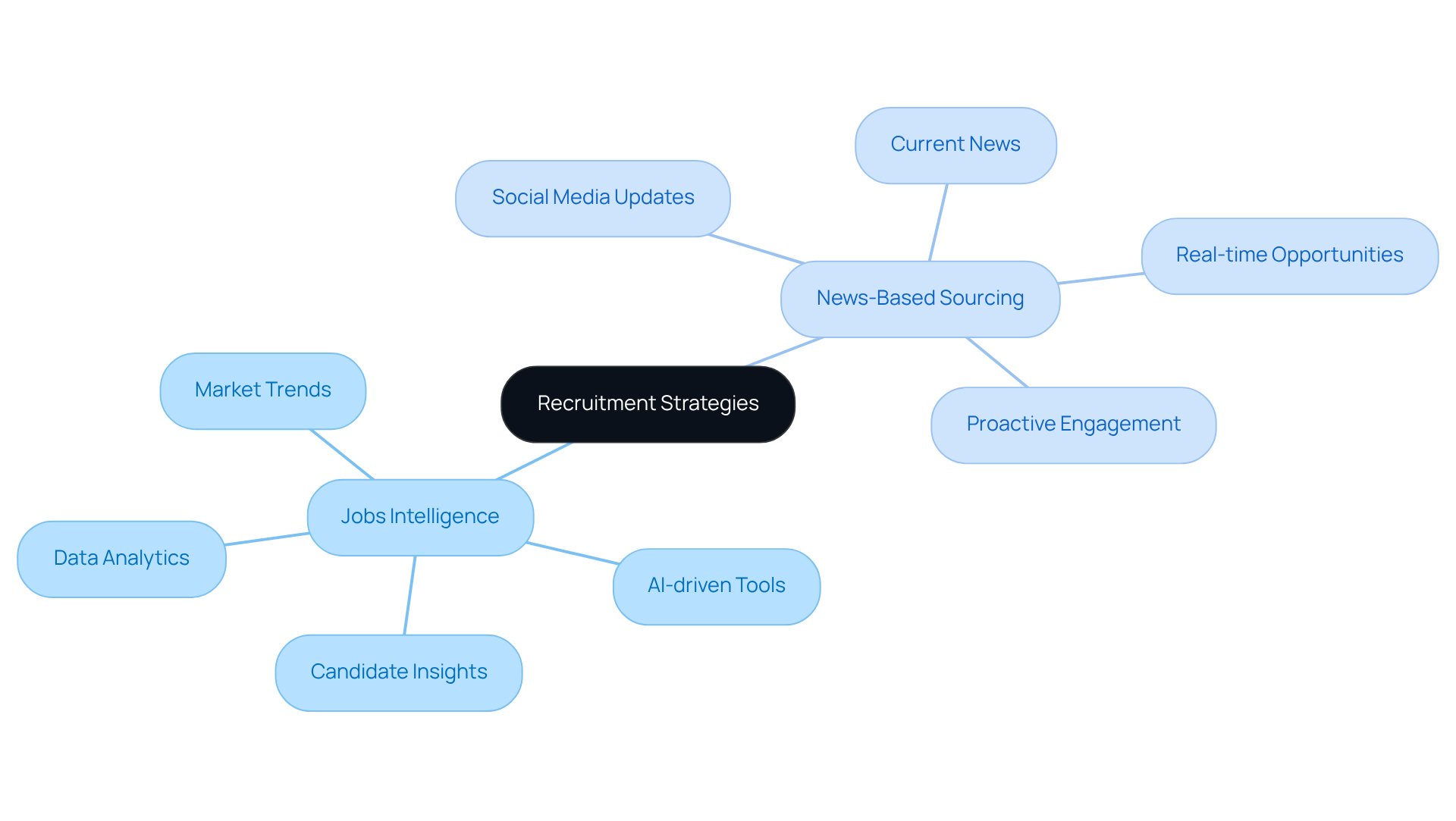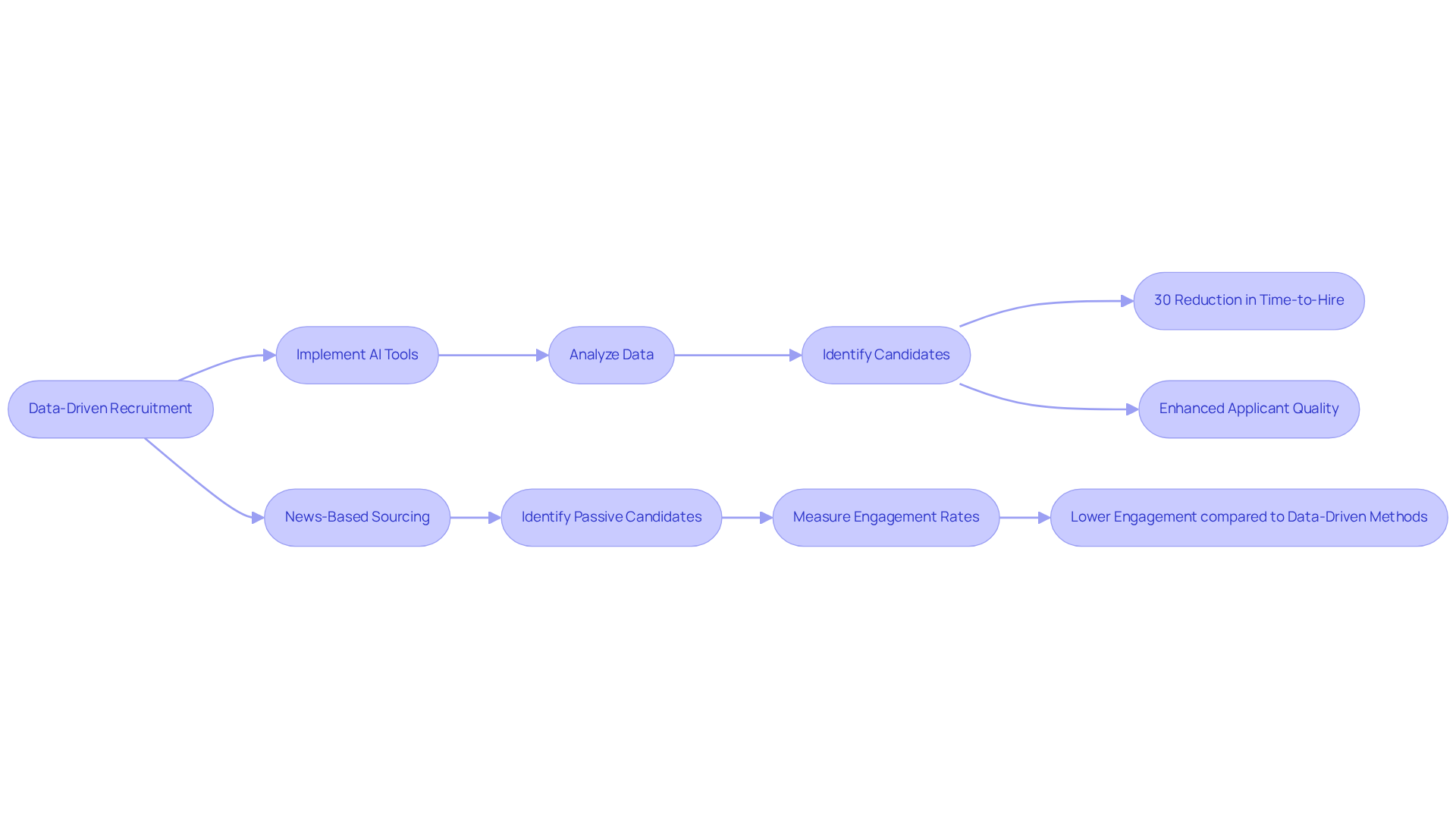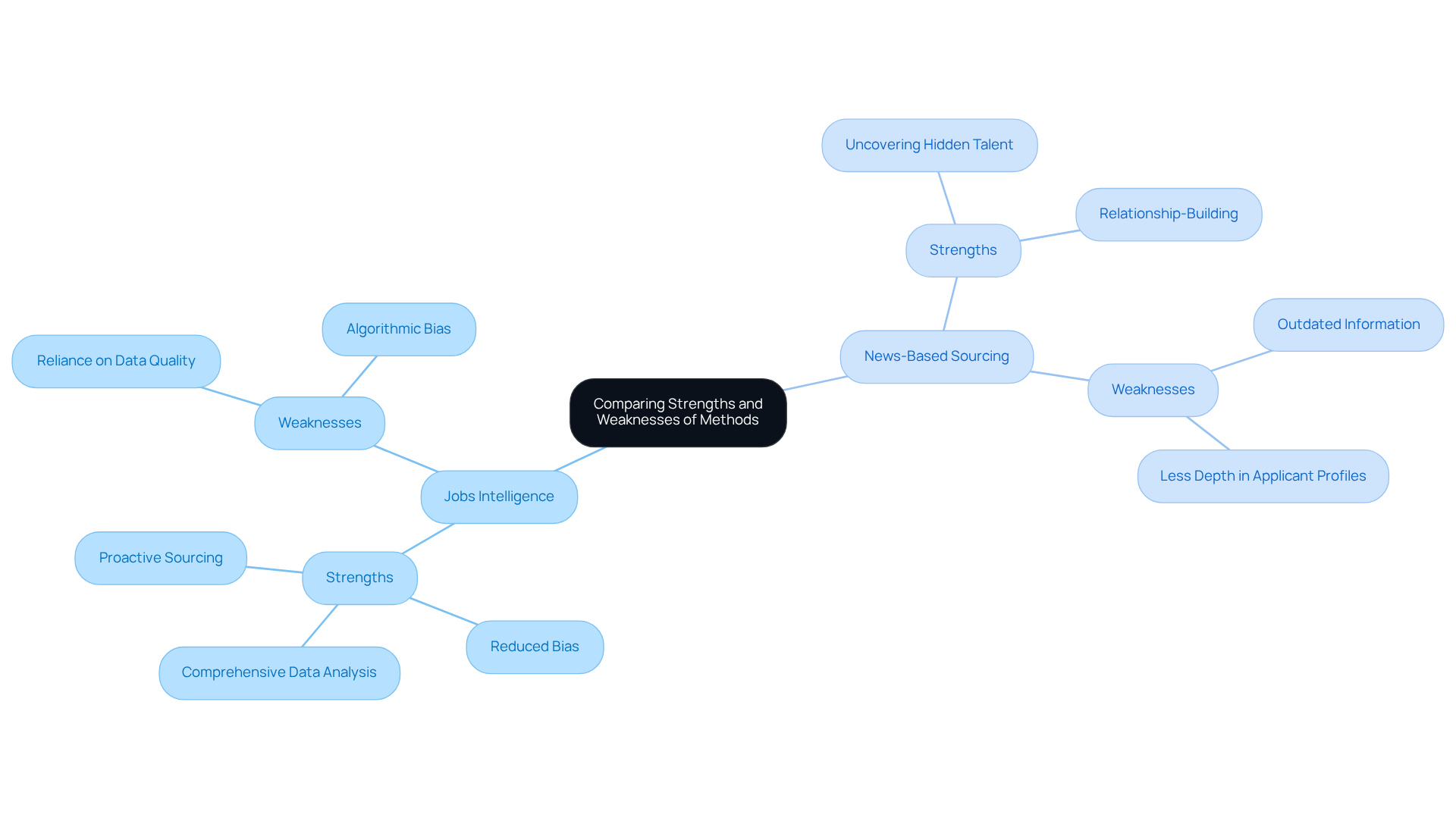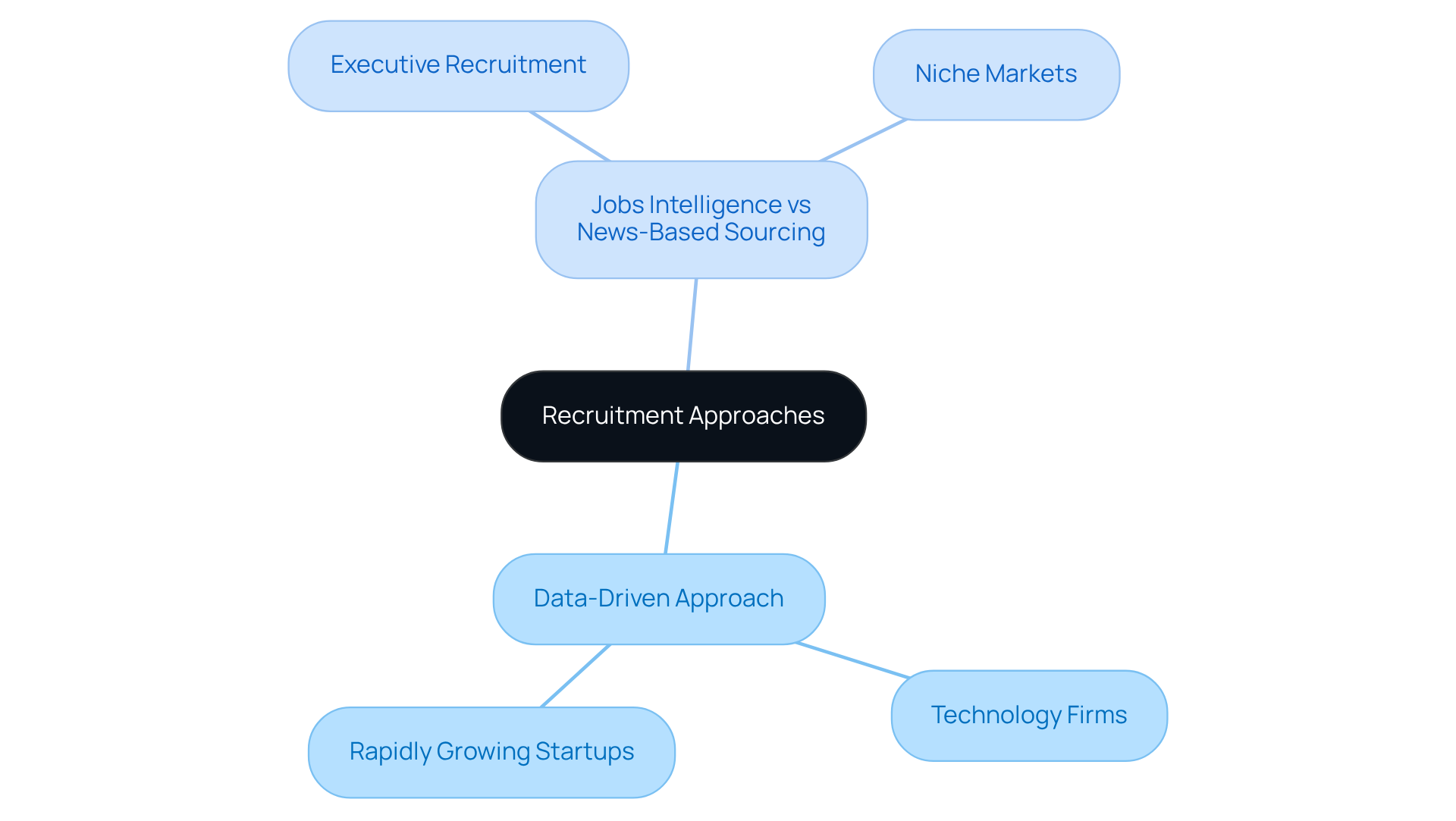Overview
This article rigorously compares Jobs Intelligence and News-Based Sourcing to ascertain which recruitment strategy proves more effective. It asserts that Jobs Intelligence, with its robust data-driven methodology, significantly reduces time-to-hire and enhances the quality of applicants. In contrast, while News-Based Sourcing has the potential to uncover passive candidates, it often leads to lower engagement rates due to its dependence on timely and relevant information. The insights derived from this analysis prompt a reevaluation of recruitment strategies, emphasizing the need for a data-centric approach in today’s competitive landscape.
Introduction
The recruitment landscape is evolving rapidly. Organizations are increasingly relying on innovative strategies to attract top talent. Among these strategies, Jobs Intelligence and News-Based Sourcing stand out, each offering unique methodologies and insights that can transform hiring practices. As recruiters weigh the benefits of data-driven analytics against the dynamic nature of real-time news sourcing, a crucial question arises: which approach truly delivers better results in identifying and engaging the right candidates? This article delves into the strengths and weaknesses of both methods, providing a comparative analysis that empowers organizations to make informed decisions tailored to their specific recruitment needs.
Defining Jobs Intelligence and News-Based Sourcing
Jobs Intelligence represents a pivotal advancement in recruitment, leveraging data analytics and AI-driven tools—most notably those offered by Websets—to identify and engage potential applicants tailored to specific job requirements and market trends. Websets' advanced adeptly manages complex queries, utilizing extensive datasets to deliver insights into candidate availability, skill sets, and market dynamics. This empowers recruiters to make informed decisions with remarkable efficiency.
In contrast, News-Based Sourcing involves harnessing current news articles, press releases, and social media updates to identify individuals or companies that may be hiring. With Websets' real-time updates spanning science, politics, finance, and startup funding, recruiters can unearth opportunities and trends within the job market. This proactive approach enables engagement with potential applicants who may not be actively seeking new roles.
Both methodologies, jobs intelligence vs news-based sourcing, aim to enhance recruitment efficiency, but they operate through distinct channels and data sources. Websets equips recruiters with the necessary tools for enriched data and targeted results, ultimately transforming the recruitment landscape. By adopting these innovative strategies, recruiters can stay ahead of the curve and effectively engage with the talent pool.

Evaluating Effectiveness in Recruitment Outcomes
Assessing the effectiveness of Jobs Intelligence reveals compelling insights: organizations that implement data-driven recruitment strategies, such as those offered by Websets, experience a notable reduction in time-to-hire and an enhancement in applicant quality. A case study exemplifies this, showcasing how a leading tech firm reduced its hiring duration by 30% after integrating Websets' AI-driven tools, which analyze extensive data to quickly identify the most suitable candidates. This capability allows recruiters to filter applicants based on skills, experience, and location, ensuring a more targeted approach.
In contrast, jobs intelligence vs news-based sourcing presents varied outcomes. While it provides access to who may not be actively pursuing employment, its success in jobs intelligence vs news-based sourcing hinges on the timeliness and relevance of the news sources employed. Recruiters may find that although they can identify potential candidates, the engagement rate often falls short compared to those sourced through Employment Analytics, which delivers more focused and data-supported insights. This highlights the importance of employing robust strategies to optimize recruitment efforts.

Comparing Strengths and Weaknesses of Each Method
Jobs Intelligence presents notable strengths, especially in its capacity for comprehensive data analysis, when considering jobs intelligence vs news-based sourcing. This capability not only enhances applicant matching but also significantly . Moreover, it enables proactive sourcing, allowing recruiters to identify potential candidates before they even enter the job market. However, it is essential to acknowledge its weaknesses, such as the reliance on data quality and the risk of algorithmic bias.
Conversely, jobs intelligence vs news-based sourcing excels in uncovering hidden talent and engaging with individuals who may not be actively seeking new opportunities. This approach fosters relationships grounded in current events and trends. Nevertheless, it is not without its drawbacks; the potential for outdated information and a lack of depth in applicant profiles may lead to less effective engagement compared to the more focused method employed by Employment Insights.
In conclusion, while both jobs intelligence vs news-based sourcing methods offer unique advantages, understanding their limitations is crucial for optimizing recruitment strategies.

Assessing Suitability for Diverse Recruitment Needs
This platform stands out as particularly beneficial for organizations requiring a swift influx of skilled applicants, such as technology firms or rapidly growing startups. Its data-driven approach excels in filling roles that demand specific skill sets and qualifications. Conversely, jobs intelligence vs news-based sourcing proves more suitable for industries where networking and relationship-building are paramount, such as executive recruitment and niche markets. This method empowers recruiters to engage candidates in a personalized manner, leveraging current events to foster rapport. Ultimately, the decision regarding jobs intelligence vs news-based sourcing should align with specific , industry demands, and the nature of the roles being filled.

Conclusion
The comparison between Jobs Intelligence and News-Based Sourcing reveals distinct methodologies that cater to varying recruitment needs. Jobs Intelligence leverages data analytics and AI to streamline the hiring process and enhance applicant quality. Conversely, News-Based Sourcing connects with passive candidates by tapping into current events. Understanding these differences is crucial for organizations aiming to optimize their recruitment strategies.
Key insights from the article highlight that Jobs Intelligence significantly reduces time-to-hire and improves candidate quality through focused data analysis. On the other hand, while News-Based Sourcing can uncover hidden talent, its effectiveness may be hampered by the reliance on timely and relevant information. Each approach has its strengths and weaknesses, making it essential for recruiters to assess their specific goals and the nature of the roles they are filling.
Ultimately, the choice between Jobs Intelligence and News-Based Sourcing should align with recruitment objectives and industry context. By leveraging the right strategy, organizations can enhance their hiring processes, ensuring they attract the best talent available. Adopting a tailored approach not only improves recruitment outcomes but also positions companies to thrive in an ever-evolving job market.
Frequently Asked Questions
What is Jobs Intelligence in recruitment?
Jobs Intelligence is an advancement in recruitment that utilizes data analytics and AI-driven tools to identify and engage potential applicants based on specific job requirements and market trends.
How does Websets contribute to Jobs Intelligence?
Websets offers an advanced AI-powered search engine that manages complex queries and utilizes extensive datasets to provide insights into candidate availability, skill sets, and market dynamics, enabling recruiters to make informed decisions efficiently.
What is News-Based Sourcing?
News-Based Sourcing involves using current news articles, press releases, and social media updates to identify individuals or companies that may be hiring, allowing recruiters to discover opportunities and trends in the job market.
How does Websets facilitate News-Based Sourcing?
Websets provides real-time updates across various sectors, including science, politics, finance, and startup funding, helping recruiters to engage with potential applicants who may not be actively seeking new roles.
What are the key differences between Jobs Intelligence and News-Based Sourcing?
Jobs Intelligence focuses on leveraging data analytics and AI to identify candidates based on specific job requirements, while News-Based Sourcing uses current news and social media to uncover hiring opportunities and trends.
How do both methodologies enhance recruitment efficiency?
Both Jobs Intelligence and News-Based Sourcing aim to improve recruitment efficiency by providing recruiters with enriched data and targeted results, allowing them to engage effectively with the talent pool.




